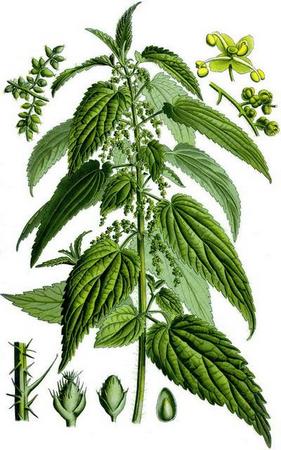Urtica dioca – Urtica dioica 50.
Perennial herb up to 100-120 cm, families krapivnыh (Urticaceae). Distributed nettles everywhere as a weed. For medical purposes, they prepare the leaves of plants.

Nettle nettle – Chemical composition
The nettle leaves contain tannin and protein substances, formic acid, glycoside urticin, vitamin K and ascorbic acid, pantothenic acid, karotinoidы, xlorofill, sitosterol, histamine, violaksantin, iron salt and wax.
Urtica dioca – Pharmacological properties
The amount of active ingredients, mainly iron salts and vitamins, contained in the nettles, normalize lipid metabolism in the body and have a stimulating effect on erythropoiesis. The drugs nettle have strong hemostatic properties, due to the presence in the plant leaves vitamin K, which stimulates the liver an essential clotting factors - prothrombin. Besides, dosage forms nettle possesses choleretic and anti-inflammatory properties and enhance regeneration processes mucous membranes of the gastrointestinal tract.
In addition to the hemostatic properties, Nettle has vasoconstrictor influence. Nettle herbal medicines increase the contractility of the smooth muscle of the uterus, like ergot medicines.
According to experimental data, contained in significant quantities in the nettle chlorophyll stimulates and tonic effect, increases basal metabolism, and increases muscle tone of the uterus and intestine, It improves the cardiovascular system and the respiratory center; It promotes granulation and epithelialization of the affected tissues.
Urtica dioca – Use in medicine
Nettle has long been used in the treatment of many human diseases. Infusion and fluid extract of nettle is used as a hemostatic agent in the lung, kidney, uterine and intestinal bleeding. Nettle herbal medicines have a selective effect on the contractility of the uterus. There are clinical observations on the use of small doses of postpartum women at the water infusion of nettle in the postpartum period. In appointing the drug in the postpartum period for 1 tablespoon 3-4 times a day for 3-5 days noted increased uterine muscle contractions, reduction of bleeding, normalization of lochia, which accelerates the process of epithelialization of the mucous membrane of the uterus, and a beneficial effect on the general condition.
Nettle is also used in atherosclerosis, iron deficiency anemia, cholecystitis, gastric, gastric ulcer and duodenal ulcer. As epiteliziruyutsya funds nettle herbal form used topically in the form of lotions trophic ulcers, seborrheic dermatitis, eczema, burns and wounds. Nettle leaves are included in the vitamin, gastric and hemostatic fees. When used in galenicals nettle therapeutic doses complications found.
Urtica dioca – Formulations, Dosing and Administration
The infusion of nettle leaves: 10 g (2 tablespoons) raw material is placed in an enamel bowl, Pour 200 ml (1 glass) hot boiled water, heated in a boiling water bath 15 m, cooled at room temperature for 45 m, filter, wring, topped up with water to 200 ml. The prepared infusion stored in a cool place no more than 2 d.
Take 1 / 2-1 / 4 cup before meals 3-5 times a day as a styptic.
Store them in a dry, cool place.
Nettle extract liquid is an alcoholic extract of nettle leaves on 70 % ethanol. Assign the same indications 25-30 drops 3 times a day 30 minutes before eating. Most liquid nettle extract used together with a liquid extract of yarrow.
Nettle leaves with fruits Rowan included in the vitamin tea, which is prepared as follows:: 3 of the dry powdered nettle leaves mixed with 7 parts of the dried fruits of mountain ash. One tablespoon of the mixture pour 2 cups boiling water, boil 10 m, insist 4 h in a tightly sealed container, filter and take 1/2 cup 3 once a day.
Nettle leaves mixed with the roots of burdock in the form of a decoction are effective for hair loss. For this purpose, use a tablespoon of the mixture of plants, taken in equal proportions, on 1 cup of boiling water. The resulting broth moisten the hair after washing and gently rub it into the skin.
